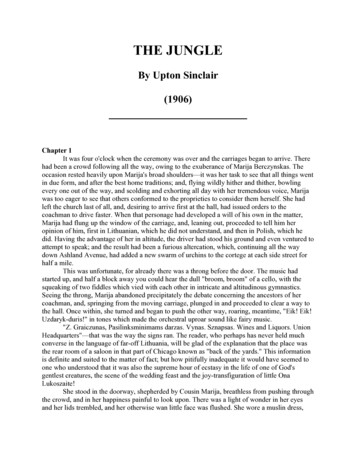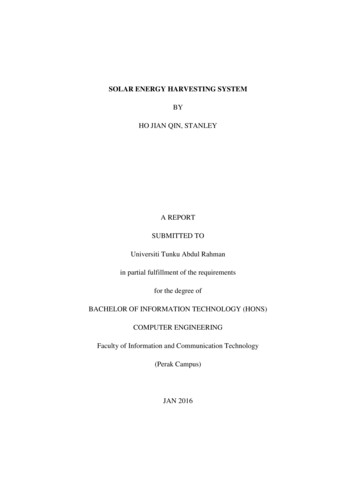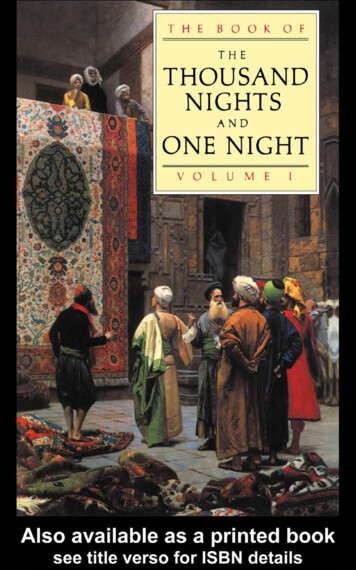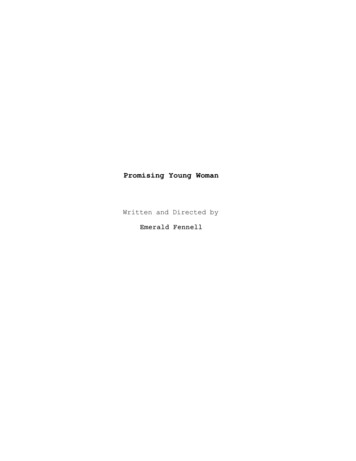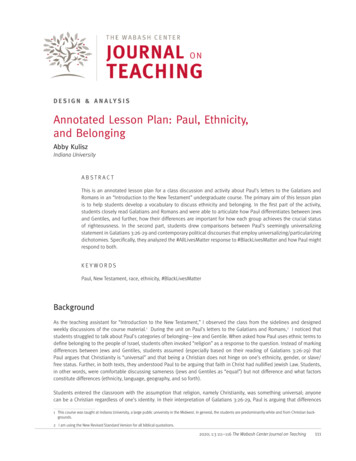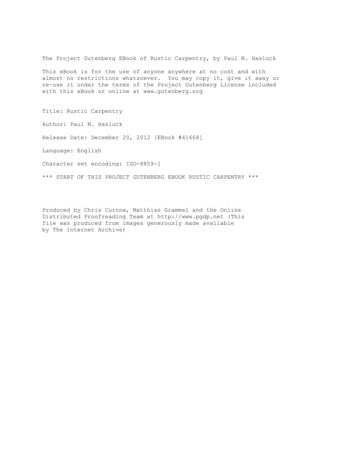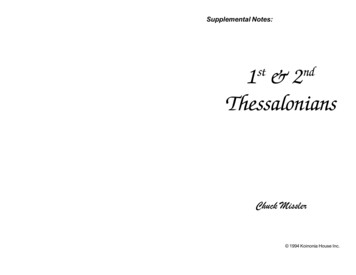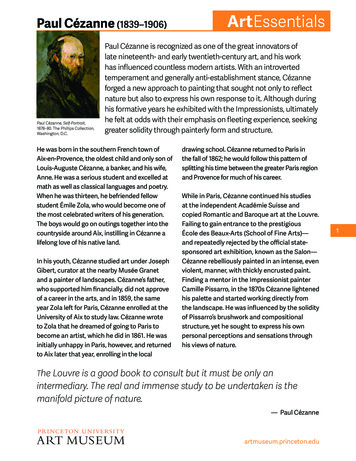
Transcription
ArtEssentialsPaul Cézanne (1839–1906)Paul Cézanne, Self-Portrait,1878–80. The Phillips Collection,Washington, D.C.Paul Cézanne is recognized as one of the great innovators oflate nineteenth- and early twentieth-century art, and his workhas influenced countless modern artists. With an introvertedtemperament and generally anti-establishment stance, Cézanneforged a new approach to painting that sought not only to reflectnature but also to express his own response to it. Although duringhis formative years he exhibited with the Impressionists, ultimatelyhe felt at odds with their emphasis on fleeting experience, seekinggreater solidity through painterly form and structure.He was born in the southern French town ofAix-en-Provence, the oldest child and only son ofLouis-Auguste Cézanne, a banker, and his wife,Anne. He was a serious student and excelled atmath as well as classical languages and poetry.When he was thirteen, he befriended fellowstudent Émile Zola, who would become one ofthe most celebrated writers of his generation.The boys would go on outings together into thecountryside around Aix, instilling in Cézanne alifelong love of his native land.In his youth, Cézanne studied art under JosephGibert, curator at the nearby Musée Granetand a painter of landscapes. Cézanne’s father,who supported him financially, did not approveof a career in the arts, and in 1859, the sameyear Zola left for Paris, Cézanne enrolled at theUniversity of Aix to study law. Cézanne wroteto Zola that he dreamed of going to Paris tobecome an artist, which he did in 1861. He wasinitially unhappy in Paris, however, and returnedto Aix later that year, enrolling in the localdrawing school. Cézanne returned to Paris inthe fall of 1862; he would follow this pattern ofsplitting his time between the greater Paris regionand Provence for much of his career.While in Paris, Cézanne continued his studiesat the independent Académie Suisse andcopied Romantic and Baroque art at the Louvre.Failing to gain entrance to the prestigiousÉcole des Beaux-Arts (School of Fine Arts)—and repeatedly rejected by the official statesponsored art exhibition, known as the Salon—Cézanne rebelliously painted in an intense, evenviolent, manner, with thickly encrusted paint.Finding a mentor in the Impressionist painterCamille Pissarro, in the 1870s Cézanne lightenedhis palette and started working directly fromthe landscape. He was influenced by the solidityof Pissarro’s brushwork and compositionalstructure, yet he sought to express his ownpersonal perceptions and sensations throughhis views of nature.The Louvre is a good book to consult but it must be only anintermediary. The real and immense study to be undertaken is themanifold picture of nature.— Paul Cézanneartmuseum.princeton.edu1
About the ArtistArtEssentialsWhat is Post-Impressionism?In 1910, the art critic Roger Fry coined the term “Post-Impressionism” as the title for anexhibition he organized in London, bringing together works by artists who came after theImpressionists, including Cézanne, Vincent van Gogh, and Paul Gauguin. Although thesethree painters’ oeuvres differ greatly in terms of subject matter and technique, the artistsshared an interest in the symbolic and emotional content of art and in the use of color tocreate form.Cézanne was friends with many of the Impressionist painters, andhe even participated in the first Impressionist exhibition (1874);however, he rejected their naturalistic approach to depicting lightand color. Unlike Claude Monet, who applied his paint in dabs ordashes, Cézanne painted discrete planes in contrasting colors. Forexample, in Cistern in the Park of Château Noir he contrasted therust and gray of the boulder with the surrounding green foliage.Small rectangles of color, set at an angle, are juxtaposed withstrong vertical and diagonal lines, which give a sense of movementand depth to the picture plane.Paul Cézanne, Cistern in the Park of Chateau Noir, ca. 1900. The Henry and Rose Pearlman Foundation, on long-term loan to the Princeton UniversityArt MuseumBetween 1899 and 1902, Cézanne worked at the Château Noir estate outside Aix-en-Provence. The neo-Gothic buildings of this peculiar country manor wereunfinished, giving it the appearance of a ruin. The modern stone cistern at Château Noir, seen at the left of this painting, contrasts with the ancient boulder atthe center; the rock’s distinctive shape suggests the flint artifacts unearthed in the region. According to local mythology, the surrounding archaeologicalattractions and strange geological formations housed magical forces.In 1869, Cézanne met a model named Marie-Hortense Fiquet, whobecame his mistress and with whom he had a son, Paul, in 1872.Fearing that his father would no longer support him financially,Cézanne kept the affair a secret. (His father finally discoveredthe situation in 1878 and did reduce his allowance as a result.)Cézanne and Hortense married in 1886, although by then theywere leading separate lives. Even so, Cézanne continued to paintportraits of Hortense until the late 1890s.Paul Cézanne, Portrait of Paul, the Artist’s Son, ca. 1880. The Henry and Rose Pearlman Foundation, onlong-term loan to the Princeton University Art MuseumCézanne rapidly executed several portraits of his son at about two years old. Although the young boymay have been too lively to sit still long enough for a formal portrait, his father attempted to capture hisappearance and personality at an age of increasing independence.artmuseum.princeton.edu2
About the ArtistArtEssentialsBy the late 1870s, Cézanne’s paintings showedincreasing emphasis on mass and structure, and hedeveloped a system of parallel brushstrokes, knownas his “constructive stroke,” that conveyed the volumeof both form and space. With mind and eye workingin concert, Cézanne built up his pictures slowly anddeliberately, often while directly confronting hismotif, whether a landscape, still-life, or portrait. Hispainstaking, analytical approach was particularly suitedto still-lifes and landscapes, which could withstand thehours of intense scrutiny Cézanne required. It is saidthat Cézanne preferred fruit to flowers for his stilllifes because flowers would wither and die before hePaul Cézanne, Three Pears, ca. 1888–90. The Henry and RosePearlman Foundation, on long-term loan to the PrincetonUniversity Art MuseumThis vibrant still-life was included in Cézanne’s first soloexhibition. The artist’s use of bold outlines for the fruitemphasizes their physicality.completed the painting.Cézanne increasingly turned to the medium of watercolor to recordsensations directly from nature and to experiment with formand structure. The quick drying time of watercolors (especiallycompared to oil paint) encouraged a more spontaneous approach,and their exceptional luminosity and transparency allowed himto play with light as a constructive element. Cézanne built upharmonies of color and used the blank areas of white paper tounify his compositions and heighten their sense of space. He wouldeventually produce almost 650 watercolors.Paul Cézanne, Route to Le Tholonet, 1900–1904. The Henry and Rose Pearlman Foundation, on long-termloan to the Princeton University Art MuseumCézanne’s watercolors had a great influence on his oil paintings. This influence is seen particularly in his use of exposed areas of blank canvas, as here (inthe unfinished section at the bottom and throughout the composition), and in passages that reveal open compositional structures, such as the diamondshaped form that is just sketched in this painting of the road that linked Aix with the village of Le Tholonet.Most of Cézanne’s mature works are rooted in the landscape of his native Provence. One of the motifsto which he returned again and again was Mont Sainte-Victoire, which dominates the countrysidenear Aix and which he could see from his studio. Mont Sainte-Victoire, the only such rocky protrusionin the region, is a prominent landmark from many vantage points. Cézanne and his childhood friends,including Émile Zola, developed an intimate relationship with this landscape, which they explored intheir youth. At the same time, they were aware of the Provençal revival, a movement that celebratedartmuseum.princeton.edu3
ArtEssentialsArtEssentialsAbout the Artistthe region’s native language, arts, and cultural traditions. MontSainte-Victoire had a symbolic role in that narrative: it was thesite of the Roman defeat of an invading Teutonic army—anevent that became the stuff of legend as well as the source ofthe mountain’s name (“Mountain of Holy Victory”). Attracted toits enduring geometric form and the changing views offered bydifferent light and angles, Cézanne painted Mont Sainte-Victoiremore than sixty times.Paul Cézanne, Mont Sainte-Victoire, ca. 1904–6. The Henry and Rose Pearlman Foundation, onlong-term loan to the Princeton University Art MuseumNearly all of Cézanne’s views of Mont Sainte-Victoire are horizontal. Here, the vertical canvasaccommodates a deep landscape portrayed in superimposed bands, and the sky above themountain is reduced, creating a solidity and stability that suggest this as one of the last views in theseries, created when Cézanne had fully mastered the motif.Cézanne struggled to find commercial and critical success throughout his life, even as his friends,including Émile Zola, began to prosper. The artist’s relationship with Zola came to an end in 1886, whenthe latter, who had always been intensely critical of his childhood friend, published L’Oeuvre, a novelabout a failed artist who commits suicide. Cézanne must have seen the character as a thinly veiledversion of himself, and no correspondence exists between the two men after a letter Cézanne wrote toZola, thanking him for sending a copy of the book.It was not until toward the end of Cézanne’s life that artists and critics began to recognize his talent.Henri Matisse and other Fauvist artists noted Cézanne’s use of the palette knife and his vigorousapplication of paint in thick marks. His approach to the geometry of nature, and the breaking downof volume into planes through color, was particularly inspirational to Pablo Picasso, who later calledCézanne his “one and only master.”Cézanne is one of the greatest of those who changed the course ofart history. From him we have learned that to alter the coloring of anobject is to alter its structure. His work proves without doubt thatpainting is not—or not any longer—the art of imitating an object bylines and colors, but of giving plastic [solid] form to our nature.— Albert Gleizes and Jean Metzinger in Du Cubisme (1912)artmuseum.princeton.edu4
A Closer LookArtEssentialsPaul CézanneMont Sainte-Victoire, ca. 1904–6The Henry and Rose Pearlman Foundation, on long-term loanto the Princeton University Art Museum.Before your visitCompare an image of Cézanne’s Mont Sainte-Victoirewith Claude Monet’s Water Lilies and Japanese Bridgeof 1899 (on view in the galleries of nineteenth-centuryEuropean art).You can download a high-res image of the Cézanne paintingfrom the Henry and Rose Pearlman Foundation’s website L1988-62-5 0.jpgYou can download a high-res image of the Monet painting fromthe Art Museum’s website at http://artimage.princeton.edu/files/5 What are the subjects of these two paintings? Which characteristics of the environment did each artist communicate? Think ofseason, time of day, weather. Which elements of painting (e.g., color, line, shape, texture, light and dark, perspective)did each artist use to communicate the subject of his painting? Where do you think you (the viewer) are in relation to the subject of each painting? What differences and similarities do you notice between these two paintings? Which elements of painting do you think Cézanne learned from Impressionism, and whichelements of Impressionism did he reject? Look at his use of color and shapes, as well asthe types of brushstrokes he used.artmuseum.princeton.edu
A Closer LookArtEssentialsDuring your visit What shapes, lines, and colors do you see in the painting? Which areas of the landscape seem closest to you? Farthest away? Why? Which areas have the most detail? Which areas did Cézanne leave unfinished? Imagine you are in Aix. What sounds can you hear? What can you smell, touch, or even taste? Cézanne painted Mont Sainte-Victoire more than sixty times. Why might an artist paintthe same motif again and again?Compare the oil painting of Mont Sainte-Victoire with a watercolor painting of the same motif,ca. 1900–1906 1988-62-44 0.jpg). What are some of the similarities and differences between the two paintings and thechoices that Cézanne made regarding shapes, colors, and composition? What are some of the differences in terms of media? How does the oil paint lookcompared to the watercolor? Cézanne often left some of the canvas or paper exposed. How does the use of blank canvasor paper effect how you respond to the work?artmuseum.princeton.edu6
A Closer LookArtEssentialsAfter your visitSelect a still-life by Cézanne and compare it to a landscape. You might choosetwo watercolors, like Still Life with Carafe, Bottle, and Fruit, ork/L1988-62-47 0.jpg)and Forest Path, about 1904–6 path) What are some of the similarities and differences between the two works you havechosen? In what ways did Cézanne structure a still-life like a landscape, and vice versa?Pablo Picasso said that Cézanne was “my one and only master . . . Cézanne was like the fatherof us all.” Select a painting from Picasso’s Analytic Cubist period, when he experimented withbreaking forms down into faceted planes, and compare it with Mont Sainte-Victoire. Someexamples include Still Life with a Bottle of Rum from 1911, in the Metropolitan Museum of 9.363.63), and Ma Jolie of 1911–12, in theMuseum of Modern Art (http://www.moma.org/collection/object.php?object id 79051) Which elements of Cézanne’s approach to painting did Picasso adopt? Look closely at hisuse of shape and line. Which elements are different? Compare the use of color and the sense of depth of thepicture plane.artmuseum.princeton.edu7
ArtEssentialsVocabularyVocabulaire en français(French vocabulary words)les mots-clés de l’analyse picturale(keywords for formal analysis)aquarelle (f.): watercolor paintingcomplémentaire: complementaryatelier (m.): workshop or studiocontrastée par: contrasted bycadre (m.): framecouleur (m.): colordessin (m.): drawingequilibre (m.): balanceen plein air: outdoorsespace (m.): spaceexposition (f.): exhibitionfond (m.): backgroundgéometrie (f.): geometryforme (f.): shapehuile (f.): oil (painting)ligne (f.): linemontagne (f.): mountainlumière (f.): lightnature morte (f.): still-lifemasse (f.): massoeuvre (m.): workmotif (m.): patternpaysage (m.): landscapenoir (m.): dark (n.); to describe a color as dark:foncé, e.g. vert foncépeintre (m.): painterpeindre: to paintpinceau (m.): paintbrushplan (m.): planeombre (f.): shadowperspective (f.): perspectivepremier plan (m.): foregroundportrait (m.): portraittableau (m.): a paintingtache (f.): mark or smudgetoile (f.): canvasartmuseum.princeton.edu8
Art in ContextArtEssentialsÉmile Zola, The MasterpieceÉmile Zola’s The Masterpiece seems to have been the catalyst for the end of the writer’s relationshipwith childhood friend Paul Cézanne. The novel’s protagonist, Claude Lantier, is described as arevolutionary painter, whose work is misunderstood by a conservative public that prefers traditionalsubjects and techniques. Set in Paris in the 1850s and ’60s, the book accurately captures thebohemian lifestyle of progressive artists in the city at that time. While Cézanne may have assumedthat Zola based Lantier on him, the character appears to be a composite of several painters whomZola knew, including Claude Monet, Édouard Manet, and Cézanne. Regardless, the novel provides anunflattering portrait of a painter who strives, yet fails, to realize his masterpiece. Lantier’s artistic aimswere clearly inspired by the goals of the Realist and Impressionist painters whose project Zola knewwell from his friends in the group and his years writing reviews of their work. The Masterpiece suggeststhat their movement never realized its potential or perhaps never found a genius up to the task. Inthe final chapter, faced with his inability to live up to his promise, Lantier hangs himself in despair.The book closes with two of the painter’s friends, Bongrand and the novelist Sandoz (who is based onZola), attending Lantier’s internment and reflecting on his tragic end. They place some of the blameon the unstable and unhealthy times in which they live and the misguided faith that people—andpainters—have placed in science and progress:9Sandoz and Bongrand had looked at the scene without saying a word. Then, having passed the fire,the former resumed:“No, [Lantier] did not prove to be the man of the formula he laid down. I mean that his genius wasnot clear enough to enable him to set that formula erect and impose it upon the world by a definitemasterpiece. And now see how other fellows scatter their efforts around him, after him! They go nofarther than roughing off, they give us mere hasty impressions, and not one of them seems to havestrength enough to become the master who is awaited. Isn’t it irritating, this new notion of light, thispassion for truth carried as far as scientific analysis, this evolution begun with so much originality,and now loitering on the way, as it were, falling into the hands of tricksters, and never coming to ahead, simply because the necessary man isn’t born? But pooh! the man will be born; nothing is everlost, light must be.”artmuseum.princeton.edu
Art in ContextArtEssentials“Who knows? not always,” said Bongrand. “Life miscarries, like everything else. I listen to you,you know, but I’m a despairer. I am dying of sadness, and I feel that everything else is dying. Ah!yes, there is something unhealthy in the atmosphere of the times—this end of a century is alldemolition, a litter of broken monuments, and soil that has been turned over and over a hundredtimes, the whole exhaling a stench of death! Can anybody remain in good health amid all that?One’s nerves become unhinged, the great neurosis is there, art grows unsettled, there is generalbustling, perfect anarchy, all the madness of self-love at bay. Never have people quarrelled moreand seen less clearly than since it is pretended that one knows everything.”Sandoz, who had grown pale, watched the large ruddy coils of smoke rolling in the wind.“It was fated,” he mused in an undertone. “Our excessive activity and pride of knowledge werebound to cast us back into doubt. This century, which has already thrown so much light overthe world, was bound to finish amid the threat of a fresh flow of darkness—yes, our discomfortcomes from that! Too much has been promised, too much has been hoped for; people have lookedforward to the conquest and explanation of everything, and now they growl impatiently. What!don’t things go quicker than that? What! hasn’t science managed to bring us absolute certainty,perfect happiness, in a hundred years? Then what is the use of going on, since one will never knoweverything, and one’s bread will always be as bitter? It is as if the century had become bankrupt,as if it had failed; pessimism twists people’s bowels, mysticism fogs their brains; for we have vainlyswept phantoms away with the light of analysis, the supernatural has resumed hostilities, the spiritof the legends rebels and wants to conquer us, while we are halting with fatigue and anguish. Ah! Icertainly don’t affirm anything; I myself am tortured. Only it seems to me that this last convulsion ofthe old religious terrors was to be foreseen. We are not the end, we are but a transition, a beginningof something else. It calms me and does me good to believe that we are marching towards reason,and the substantiality of science.”.Then Sandoz, making up his mind to leave the grave, which was now half filled, resumed:“We alone shall have known him. There is nothing left of him, not even a name!”The complete French text of Zola’s L’Oeuvre and Ernest Alfred Vizetelly’s complete Englishtranslation, The Masterpiece, can be found at Project ceton.edu10
Art in ContextArtEssentialsThe following works were consulted in the preparation of this guide:Giles, Laura M., and Carol Armstrong, eds. Cézanne in Focus. Watercolors from the Henry and RosePearlman Collection. Princeton: Princeton University Art Museum, 2002.The Henry and Rose Pearlman ka, Pavel. Cézanne: Landscape into Art. New Haven: Yale University Press, 1996.Paul Cézanne. The Museum of Modern st id 1053Verdi, Richard. Cézanne. New York: Thames and Hudson, 1992.Voorhies, James. “Paul Cézanne (1839–1906).” In Heilbrunn Timeline of Art History. New York:Metropolitan Museum of Art, 2000–.http://www.metmuseum.org/toah/hd/pcez/hd pcez.htm11Educational programs during Cézanne and the Modern:Masterpieces of European Art from the Pearlman Collection havebeen underwritten by the Heart of Neiman Marcus Foundation.artmuseum.princeton.edu
Paul Cézanne, Portrait of Paul, the Artist’s Son, ca. 1880. The Henry and Rose Pearlman Foundation, on long-term loan to the Princeton University Art Museum Cézanne rapidly executed several portraits of his so
